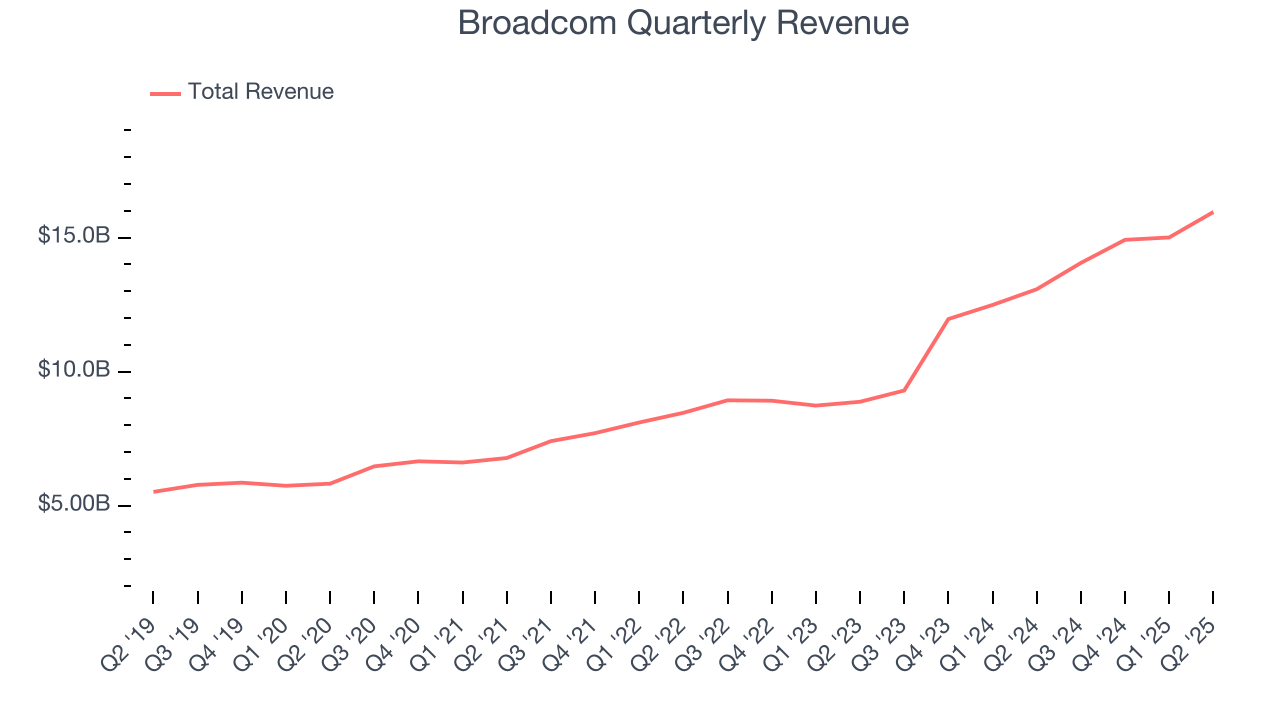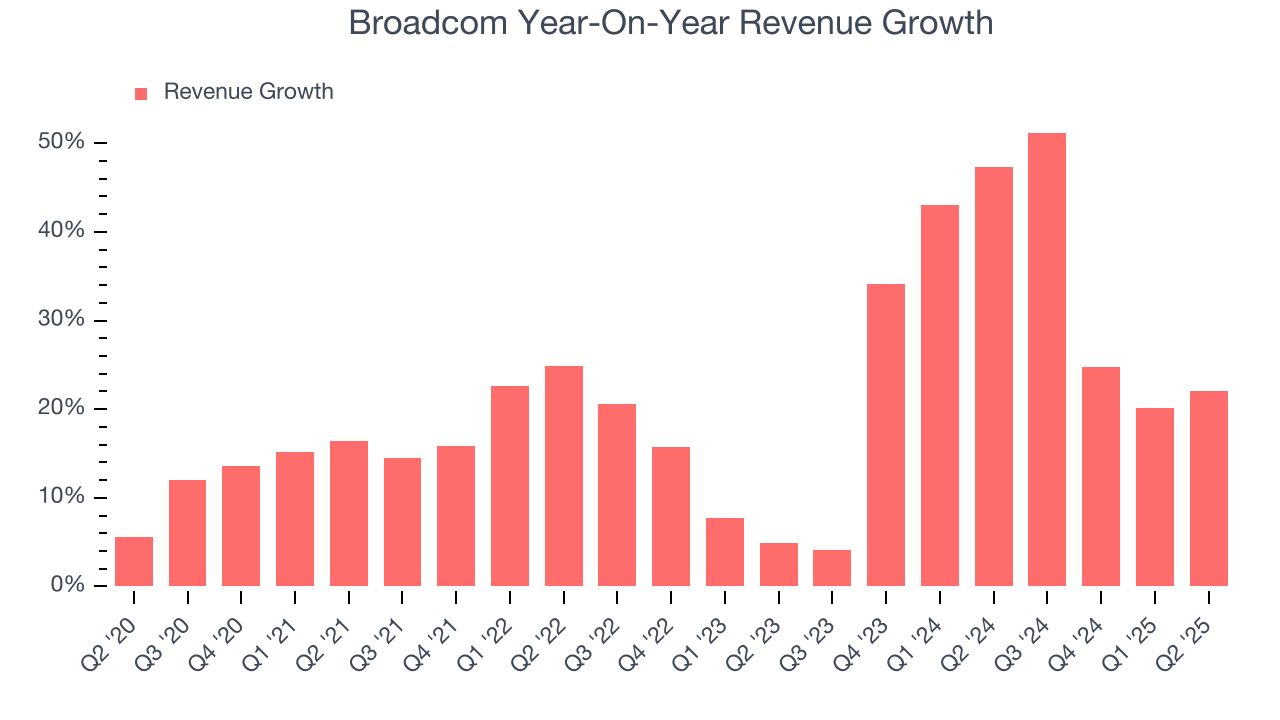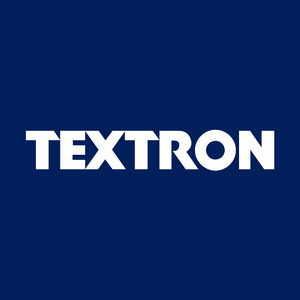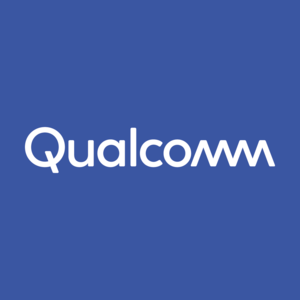
Broadcom (AVGO)
Broadcom is an amazing business. Its combination of fast growth, robust profitability, and superb prospects makes it a coveted asset.― StockStory Analyst Team
1. News
2. Summary
Why We Like Broadcom
Originally the semiconductor division of Hewlett Packard, Broadcom (NASDAQ:AVGO) is a semiconductor conglomerate spanning wireless communications, networking, and data storage as well as infrastructure software focused on mainframes and cybersecurity.
- Impressive 30% annual revenue growth over the last two years indicates it’s winning market share this cycle
- Revenue outlook for the upcoming 12 months is outstanding and shows it’s on track to gain market share
- Offerings are difficult to replicate at scale and lead to a best-in-class gross margin of 76.1%


Broadcom is a top-tier company. The price looks reasonable in light of its quality, and we think now is a prudent time to buy the stock.
Why Is Now The Time To Buy Broadcom?
High Quality
Investable
Underperform
Why Is Now The Time To Buy Broadcom?
Broadcom is trading at $392.96 per share, or 45.2x forward P/E. It’s an optically-rich valuation that could make for some stock-price volatility. However, we think the multiple is reasonable given its business quality.
Entry price may seem important in the moment, but our work shows that time and again, long-term market outperformance is determined by business quality rather than getting an absolute bargain on a stock.
3. Broadcom (AVGO) Research Report: Q2 CY2025 Update
Fabless chip and software maker Broadcom (NASDAQ:AVGO) met Wall Street’s revenue expectations in Q2 CY2025, with sales up 22% year on year to $15.95 billion. The company expects next quarter’s revenue to be around $17.4 billion, coming in 2.1% above analysts’ estimates. Its non-GAAP profit of $1.69 per share was 1.6% above analysts’ consensus estimates.
Broadcom (AVGO) Q2 CY2025 Highlights:
- Revenue: $15.95 billion vs analyst estimates of $15.9 billion (22% year-on-year growth, in line)
- Adjusted EPS: $1.69 vs analyst estimates of $1.66 (1.6% beat)
- Adjusted EBITDA: $10.7 billion vs analyst estimates of $10.46 billion (67.1% margin, 2.3% beat)
- Revenue Guidance for Q3 CY2025 is $17.4 billion at the midpoint, above analyst estimates of $17.05 billion
- Operating Margin: 36.9%, up from 29% in the same quarter last year
- Free Cash Flow Margin: 44%, up from 36.7% in the same quarter last year
- Inventory Days Outstanding: 54, down from 56 in the previous quarter
- Market Capitalization: $1.58 trillion
Company Overview
Originally the semiconductor division of Hewlett Packard, Broadcom (NASDAQ:AVGO) is a semiconductor conglomerate spanning wireless communications, networking, and data storage as well as infrastructure software focused on mainframes and cybersecurity.
Today’s Broadcom traces its roots to the chip division of Agilent Technologies, which was acquired by private equity giants KKR and Silver Lake in 2005, renamed Avago and put under the guidance of CEO Hock Tan. Since 2005, its strategy has been to acquire leading infrastructure technology providers, and improve their margins and FCF by integrating their back office and sales functions into its platform and running the businesses with an emphasis on profitability over growth at any cost.
Over time, the acquired companies diversified Broadcom’s business model and the improved free cash flow provides the capital for further acquisitions. In the past decade Hock Tan’s Avago has spent over $70 billion acquiring CYOptics, LSI, Emulex, Broadcom (whose name it adopted), Brocade, CA, and Symantec’s enterprise security business.
Broadcom’s semiconductor business provides chips used in smartphones, data centers, set top boxes, servers, telecom, and networking systems. Its software business focuses on infrastructure and security, with key businesses in database, application development, endpoint security, and identity management.
Broadcom’s peers and competitors in semiconductors include Analog Devices (NASDAQ: ADI), Cisco Systems (NASDAQ: CSCO), Intel (NASDAQ:INTC), MediaTek (TWSE:2454), Marvell Technology (NASDAQ:MRVL), NXP Semiconductors NV (NASDAQ:NXPI), Qualcomm (NASDAQ:QCOM), Qorvo (NASDAQ: QRVO), and Skyworks (NASDAQ:SWKS). Its software rivals are Atlassian (NASDAQ:TEAM), CrowdStrike (NASDAQ:CRWD), IBM (NYSE:IBM), Oracle (NYSE:ORCL), ServiceNow (NASDAQ:NOW), Splunk (NASDAQ:SPLK), and VMware (NYSE: VMW).
4. Processors and Graphics Chips
Chips need to keep getting smaller in order to advance on Moore’s law, and that is proving increasingly more complicated and expensive to achieve with time. That has caused most digital chip makers to become “fabless” designers, rather than manufacturers, instead relying on contracted foundries like TSMC to manufacture their designs. This has benefitted the digital chip makers’ free cash flow margins, as exiting the manufacturing business has removed large cash expenses from their business models.
5. Revenue Growth
A company’s long-term sales performance can indicate its overall quality. Any business can experience short-term success, but top-performing ones enjoy sustained growth for years. Thankfully, Broadcom’s 20.9% annualized revenue growth over the last five years was incredible. Its growth surpassed the average semiconductor company and shows its offerings resonate with customers, a great starting point for our analysis. Semiconductors are a cyclical industry, and long-term investors should be prepared for periods of high growth followed by periods of revenue contractions (which can sometimes offer opportune times to buy).

We at StockStory place the most emphasis on long-term growth, but within semiconductors, a half-decade historical view may miss new demand cycles or industry trends like AI. Broadcom’s annualized revenue growth of 30% over the last two years is above its five-year trend, suggesting its demand was strong and recently accelerated. 
This quarter, Broadcom’s year-on-year revenue growth of 22% was excellent, and its $15.95 billion of revenue was in line with Wall Street’s estimates. Company management is currently guiding for a 23.8% year-on-year increase in sales next quarter.
Looking further ahead, sell-side analysts expect revenue to grow 30.5% over the next 12 months, similar to its two-year rate. This projection is eye-popping for a company of its scale and indicates the market sees success for its products and services.
6. Product Demand & Outstanding Inventory
Days Inventory Outstanding (DIO) is an important metric for chipmakers, as it reflects a business’ capital intensity and the cyclical nature of semiconductor supply and demand. In a tight supply environment, inventories tend to be stable, allowing chipmakers to exert pricing power. Steadily increasing DIO can be a warning sign that demand is weak, and if inventories continue to rise, the company may have to downsize production.
This quarter, Broadcom’s DIO came in at 54, which is 9 days below its five-year average. At the moment, these numbers show no indication of an excessive inventory buildup.

7. Gross Margin & Pricing Power
In the semiconductor industry, a company’s gross profit margin is a critical metric to track because it sheds light on its pricing power, complexity of products, and ability to procure raw materials, equipment, and labor.
Broadcom’s gross margin is one of the best in the semiconductor sector, and its differentiated products give it strong pricing power. As you can see below, it averaged an elite 76.1% gross margin over the last two years. That means Broadcom only paid its suppliers $23.90 for every $100 in revenue. 
Broadcom produced a 76.8% gross profit margin in Q2, in line with the same quarter last year. Zooming out, Broadcom’s full-year margin has been trending up over the past 12 months, increasing by 2.5 percentage points. If this move continues, it could suggest better unit economics due to more leverage from its growing sales on the fixed portion of its cost of goods sold (such as manufacturing expenses).
8. Operating Margin
Broadcom has been a well-oiled machine over the last two years. It demonstrated elite profitability for a semiconductor business, boasting an average operating margin of 33.4%. This result isn’t surprising as its high gross margin gives it a favorable starting point.
Analyzing the trend in its profitability, Broadcom’s operating margin rose by 9.6 percentage points over the last five years, as its sales growth gave it operating leverage.

This quarter, Broadcom generated an operating margin profit margin of 36.9%, up 7.9 percentage points year on year. The increase was solid, and because its operating margin rose more than its gross margin, we can infer it was more efficient with expenses such as marketing, R&D, and administrative overhead.
9. Earnings Per Share
Revenue trends explain a company’s historical growth, but the long-term change in earnings per share (EPS) points to the profitability of that growth – for example, a company could inflate its sales through excessive spending on advertising and promotions.
Broadcom’s EPS grew at a remarkable 24.3% compounded annual growth rate over the last five years, higher than its 20.9% annualized revenue growth. This tells us the company became more profitable on a per-share basis as it expanded.

We can take a deeper look into Broadcom’s earnings to better understand the drivers of its performance. As we mentioned earlier, Broadcom’s operating margin expanded by 9.6 percentage points over the last five years. This was the most relevant factor (aside from the revenue impact) behind its higher earnings; interest expenses and taxes can also affect EPS but don’t tell us as much about a company’s fundamentals.
In Q2, Broadcom reported adjusted EPS of $1.69, up from $1.24 in the same quarter last year. This print beat analysts’ estimates by 1.6%. Over the next 12 months, Wall Street expects Broadcom’s full-year EPS of $6.29 to grow 23.4%.
10. Cash Is King
Free cash flow isn't a prominently featured metric in company financials and earnings releases, but we think it's telling because it accounts for all operating and capital expenses, making it tough to manipulate. Cash is king.
Broadcom has shown terrific cash profitability, and if sustainable, puts it in an advantageous position to invest in new products, return capital to investors, and consolidate the market during industry downturns. The company’s free cash flow margin was among the best in the semiconductor sector, averaging an eye-popping 40.8% over the last two years.
Taking a step back, we can see that Broadcom’s margin dropped by 7.9 percentage points over the last five years. If its declines continue, it could signal increasing investment needs and capital intensity.

Broadcom’s free cash flow clocked in at $7.02 billion in Q2, equivalent to a 44% margin. This result was good as its margin was 7.4 percentage points higher than in the same quarter last year. Its cash profitability was also above its two-year level, and we hope the company can build on this trend.
11. Return on Invested Capital (ROIC)
EPS and free cash flow tell us whether a company was profitable while growing its revenue. But was it capital-efficient? A company’s ROIC explains this by showing how much operating profit it makes compared to the money it has raised (debt and equity).
Although Broadcom has shown solid business quality lately, it historically did a mediocre job investing in profitable growth initiatives. Its five-year average ROIC was 16.3%, somewhat low compared to the best semiconductor companies that consistently pump out 35%+.

12. Balance Sheet Assessment
Broadcom reported $10.72 billion of cash and $64.23 billion of debt on its balance sheet in the most recent quarter. As investors in high-quality companies, we primarily focus on two things: 1) that a company’s debt level isn’t too high and 2) that its interest payments are not excessively burdening the business.

With $39.88 billion of EBITDA over the last 12 months, we view Broadcom’s 1.3× net-debt-to-EBITDA ratio as safe. We also see its $2.90 billion of annual interest expenses as appropriate. The company’s profits give it plenty of breathing room, allowing it to continue investing in growth initiatives.
13. Key Takeaways from Broadcom’s Q2 Results
A highlight during the quarter was Broadcom’s improvement in inventory levels. We were also happy its adjusted operating income outperformed Wall Street’s estimates. On the other hand, its revenue guidance for next quarter was in line. Zooming out, we think this was a mixed quarter. The stock remained flat at $334.90 immediately following the results.
14. Is Now The Time To Buy Broadcom?
Updated: December 6, 2025 at 9:18 PM EST
A common mistake we notice when investors are deciding whether to buy a stock or not is that they simply look at the latest earnings results. Business quality and valuation matter more, so we urge you to understand these dynamics as well.
Broadcom is one of the best semiconductor companies out there. For starters, its revenue growth was exceptional over the last five years and is expected to accelerate over the next 12 months. And while its cash profitability fell over the last five years, its admirable gross margins indicate robust pricing power. Additionally, Broadcom’s powerful free cash flow generation enables it to stay ahead of the competition through consistent reinvestment of profits.
Broadcom’s P/E ratio based on the next 12 months is 45.2x. You get what you pay for, and in this case, the higher valuation is warranted because Broadcom’s fundamentals clearly illustrate it’s a special business. We think the stock is attractive here.
Wall Street analysts have a consensus one-year price target of $411.06 on the company (compared to the current share price of $392.96), implying they see 4.6% upside in buying Broadcom in the short term.











